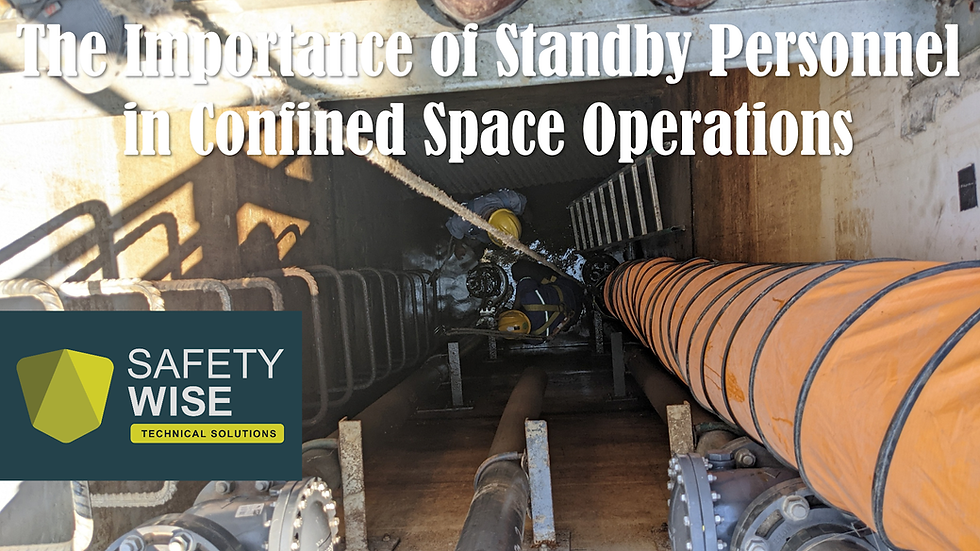The Importance of Standby Personnel in Confined Space Operations
- Luke Dam
- Aug 6
- 5 min read

Confined space operations are among the most hazardous activities across various industries, including utilities, construction, mining, and oil and gas. The combination of limited access, poor ventilation, potential for atmospheric hazards, and restricted movement makes working in confined spaces particularly dangerous.
In these high-risk environments, the role of the standby person is not just important—it’s essential. Often overlooked or misunderstood, the standby personnel function as the critical link between confined space entrants and a successful outcome, particularly in emergency situations.
In this article, we’ll explore the vital role of standby personnel in confined space operations, covering the legal requirements, practical responsibilities, emergency scenarios, selection and training considerations, and the risks of getting it wrong.
1. Who Is the Standby Person?
Also referred to as a confined space observer, hole watch, or safety attendant, the standby person is a trained individual stationed outside the confined space who maintains continuous communication with those inside.
They are tasked with:
Monitoring the well-being of workers inside the space
Maintaining logs and permits
Observing atmospheric readings
Initiating emergency response if needed
Preventing unauthorised entry
Importantly, the standby person is not a passive observer. They are an active safety agent and often the first (and sometimes only) line of defence when something goes wrong.
2. Why Standby Personnel Are Essential
First Line of Emergency Response
When something goes wrong in a confined space—such as a collapse, toxic exposure, or entrapment—the standby person is the first to raise the alarm. Their ability to react quickly can mean the difference between life and death.
Real-Time Monitoring
Even with gas monitors and alarms, there is no substitute for human observation. A vigilant standby person can detect subtle signs of danger, such as unusual noises, loss of communication, or signs of fatigue or distress in the worker.
Gatekeeper Role
The standby person ensures that only authorised and adequately trained personnel enter the confined space. This reduces the risk of untrained workers placing themselves in danger or compromising rescue efforts.
Compliance and Documentation
They manage entry permits, conduct headcounts, track atmospheric readings, and ensure all procedural steps are followed. In the event of an incident, this documentation is crucial for investigations and legal compliance.
3. Legal Requirements
In Australia, the role of the standby person is embedded within various WHS Regulations, codes of practice, and other documentation, including:
Model WHS Regulations – Part 4.3 – Confined Spaces
Safe Work Australia Code of Practice: Confined Spaces
AS 2865 – Confined Spaces (Australian Standard)
According to these documents:
A standby person must be assigned for any entry into a confined space.
The person must be trained, competent, and not assigned other duties that could distract them.
They must not enter the space themselves unless they are part of a properly trained rescue team equipped with the necessary gear.
Similar requirements exist in international jurisdictions such as OSHA 1910.146 (USA) and the UK’s Confined Spaces Regulations 1997.
Failing to provide a standby person not only breaches compliance, but it also dramatically increases the risk of fatal outcomes.
4. Duties and Responsibilities
The standby person is a multi-skilled role. Core responsibilities include:
Continuous Observation
They must maintain line-of-sight or audio communication with those inside at all times. If visual access is not possible, a combination of two-way radios and camera systems may be used.
Communication
Maintaining regular contact with entrants helps monitor their well-being, detect any issues, and verify their safe progress.
Monitoring Atmospheric Conditions
The standby person may be responsible for monitoring real-time gas readings and ensuring environmental conditions remain within safe limits.
Control Entry and Exit
They ensure that entry and exit procedures are followed, using a confined space entry log or permit system.
Emergency Response
In an emergency, they must:
Raise the alarm
Initiate the emergency plan
Notify the rescue team
Stay calm and provide clear information to emergency responders
Crucially, they should not enter the space themselves unless they are trained and equipped to do so- many fatalities have resulted from would-be rescuers becoming victims themselves.
5. Selection and Training of Standby Personnel
Not Just Anyone Will Do
Assigning an untrained or inattentive person to the standby role can be deadly. The selection criteria should include:
Confined space training and refreshers
Strong situational awareness
Good communication skills
Ability to stay calm under pressure
Basic first aid and emergency response knowledge
Understanding of the specific hazards associated with the task at hand
Scenario-Based Training
Training should go beyond theoretical instruction. Simulation drills, realistic emergency scenarios, and mock rescues are essential to developing confidence and capability.
6. Common Failures and Near Misses
Let’s explore some real-world examples where inadequate standby procedures have had tragic consequences—or were narrowly avoided.
Valero Refinery – Two Would‑Be Rescuers Fatally Overcome (Delaware, 2005)
Two contractors entered a vessel being purged with nitrogen and were suffocated due to an oxygen‑deficient atmosphere.
The second worker attempted a rescue without proper training or backup and also died.
Highlights the critical need for trained standby personnel and rescue planning.
Bethlehem Steel Shipyard Fatality (Palatka, FL, 2023)
A welder entered a confined area in a ship hull without atmospheric testing. He collapsed from oxygen deficiency; a supervisor and a third co‑worker also collapsed trying to rescue him.
The entering worker died. OSHA concluded that no proper monitoring or standby procedure was in place.
Oklahoma Wellsite Confined Space Fatality (Purcell, OK, 2023)
The worker entered a permit‑required tank without atmospheric testing or standby coverage and died of asphyxiation. Two coworkers attempting a rescue suffered exposure effects.
OSHA fined the employer for failing to assess hazards, implement ventilation or rescue procedures, and assign standby personnel.
7. Psychological and Cultural Challenges
Being a standby person isn’t always seen as a “desirable” role. Some employees see it as a boring or easy job, but that mindset must be challenged.
The “Just Watching” Myth
There’s nothing passive about being on standby. It requires sustained attention, technical knowledge, and emotional resilience.
Boredom and Complacency
The longer a shift drags on, the greater the risk of distraction. Fatigue management and job rotation can help maintain alertness.
Organisational Culture
Companies must foster a culture where the standby role is respected and understood. Recognising the importance of this function through proper training, reward systems, and communication helps reinforce its value.
8. Integrating Technology
Technology can support, though not replace, the role of standby personnel. Some helpful tools include:
Wireless gas monitors with live feeds
Bodycams for remote observation
Alarm systems linked to mobile devices
Digital permit systems
AI-driven fatigue monitoring
However, no matter how advanced the technology, the human element remains irreplaceable.
9. Building a Strong System
To ensure adequate standby coverage in confined space operations, consider the following best practices:
Risk Assessments: Tailor the standby plan to the specific hazards of each confined space.
Redundancy: In high-risk jobs, use dual standby personnel for coverage and backup.
Emergency Drills: Regularly test your response procedures, including communications and rescue.
Competency Reviews: Reassess standby team capabilities annually or after significant changes.
Fatigue Controls: Limit shift durations and ensure access to rest breaks.
Cross-Training: Ensure multiple people are trained to act as a standby to support job flexibility.
Conclusion: More Than a Spotter
Standby personnel are more than just eyes on a hole- they are a critical safeguard against injury and death in confined space operations.
When chosen carefully, trained thoroughly, and empowered through systems and culture, standby observers become an indispensable part of your safety ecosystem.
Neglecting this role, or treating it as an afterthought, is a shortcut to disaster. In confined spaces, there’s little room for error, and the standby person is there to make sure that error never becomes a tragedy.




Comments